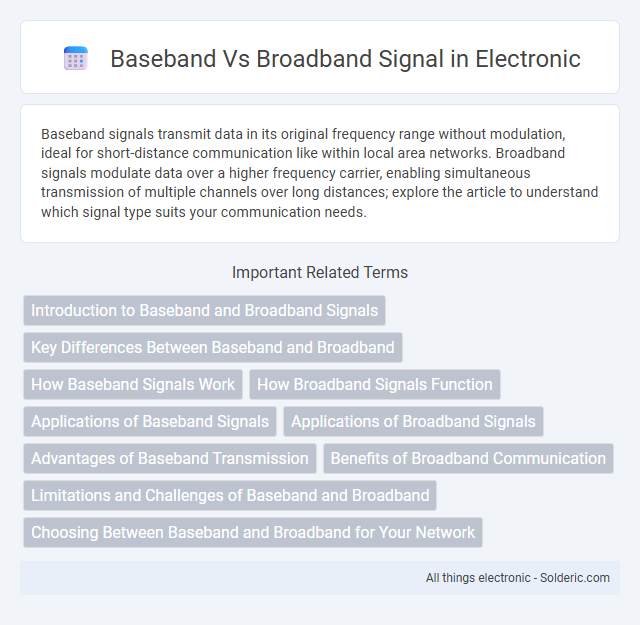Baseband signals transmit data in its original frequency range without modulation, ideal for short-distance communication like within local area networks. Broadband signals modulate data over a higher frequency carrier, enabling simultaneous transmission of multiple channels over long distances; explore the article to understand which signal type suits your communication needs.
Comparison Table
| Feature | Baseband Signal | Broadband Signal |
|---|---|---|
| Definition | Signal transmitted without modulation, occupying the entire bandwidth. | Signal modulated to occupy multiple frequency bands simultaneously. |
| Frequency Range | Low-frequency range; starts from zero Hz. | Wide frequency range; uses multiple channels at different frequencies. |
| Usage | Used in local-area networks (LANs), digital signaling. | Used in cable TV, internet, long-distance communication. |
| Bandwidth | Uses entire bandwidth for a single signal. | Divides bandwidth for multiple simultaneous signals. |
| Transmission | Transmits digital signals directly. | Transmits analog signals via modulation. |
| Signal Types | Typically digital signals. | Typically analog or modulated digital signals. |
| Example Technologies | Ethernet, digital baseband communication. | Cable modems, DSL, broadband internet. |
| Advantages | Simple, low cost, less interference. | Allows multiple channels, efficient bandwidth usage. |
| Disadvantages | Limited range, cannot carry multiple signals simultaneously. | More complex, higher cost, requires modulation/demodulation. |
Introduction to Baseband and Broadband Signals
Baseband signals are digital or analog signals that occupy the entire bandwidth of the transmission medium, enabling direct transmission without modulation, typically used in Ethernet and local area networks. Broadband signals utilize multiple frequency bands to transmit several signals simultaneously, often modulating data over higher frequencies for applications like cable television and internet services. Understanding the fundamental difference in bandwidth usage and signal transmission methods between baseband and broadband is crucial for optimizing communication system design.
Key Differences Between Baseband and Broadband
Baseband signals transmit data over a single channel using direct digital or analog pulses, making them ideal for short-distance communication like Ethernet networks. Broadband signals carry multiple frequency ranges simultaneously through modulation, supporting long-distance communication such as cable TV and internet services. Understanding these key differences allows you to select the right technology for your specific data transmission needs.
How Baseband Signals Work
Baseband signals transmit data in their original frequency range, using digital pulses that vary directly to represent binary information. These signals occupy the entire bandwidth of the transmission medium, allowing efficient use of cable or channel without frequency shifting. Your communication system benefits from baseband signaling by ensuring clear, unmodulated pulses over short distances, ideal for LAN connections and digital data transfer.
How Broadband Signals Function
Broadband signals transmit multiple frequency channels simultaneously by dividing the available bandwidth into distinct frequency bands for each data stream, enabling the concurrent transfer of diverse information such as voice, video, and internet traffic. Your broadband connection modulates signals across these traffic channels using techniques like frequency-division multiplexing (FDM), maximizing efficient use of the transmission medium. This method contrasts with baseband signals, which send data as digital pulses over a single frequency channel without modulation.
Applications of Baseband Signals
Baseband signals are widely used in digital communication systems such as Ethernet networks and telecommunication channels, where data is transmitted without modulation over a single frequency range. They facilitate high-speed data transfer in local area networks (LANs) and are essential in systems like digital audio and video transmission, ensuring clear, interference-free delivery. Your devices rely on baseband signals for efficient, direct data communication within confined environments.
Applications of Broadband Signals
Broadband signals are widely used in high-speed internet, cable television, and wireless communication systems due to their ability to transmit multiple channels simultaneously over a wide frequency range. These signals enable data streaming, video conferencing, and real-time online gaming by supporting higher bandwidth and faster data rates compared to baseband signals. Your network infrastructure benefits from broadband technology by providing enhanced connectivity and improved user experiences in modern digital communication.
Advantages of Baseband Transmission
Baseband transmission offers the advantage of simple implementation due to its use of digital signals, which reduces noise and interference, ensuring high signal integrity over short distances. It enables efficient use of the entire bandwidth of the transmission medium, providing faster and more reliable communication for local networks. Your data benefits from enhanced security and minimal signal distortion, making baseband ideal for environments requiring clear and direct signal transmission.
Benefits of Broadband Communication
Broadband communication supports high data rates over wide frequency ranges, enabling simultaneous transmission of multiple signals or channels. Your network benefits from enhanced bandwidth efficiency, reduced latency, and improved capacity for multimedia services such as streaming and video conferencing. This technology facilitates reliable, scalable connectivity essential for modern digital communication infrastructure.
Limitations and Challenges of Baseband and Broadband
Baseband signals face limitations in transmission distance and bandwidth, as they can only carry one signal at a time and are susceptible to noise interference, restricting their use in long-distance communications. Broadband signals tackle these issues by enabling multiple signals over a single channel using various frequency bands, but they demand more complex hardware and higher costs for modulation and demodulation processes. Your choice between baseband and broadband depends on the required data rates, signal clarity, and infrastructure capabilities to manage these inherent challenges efficiently.
Choosing Between Baseband and Broadband for Your Network
Baseband signals transmit data over a single channel using digital pulses, making them ideal for short-distance, high-speed communication within LANs. Broadband signals modulate data across multiple frequencies simultaneously, supporting long-distance transmission and multiple users for applications like cable TV and internet services. Choosing between baseband and broadband depends on your network's distance requirements, bandwidth needs, and the type of data transmission appropriate for your specific environment.
Baseband vs broadband signal Infographic

 solderic.com
solderic.com